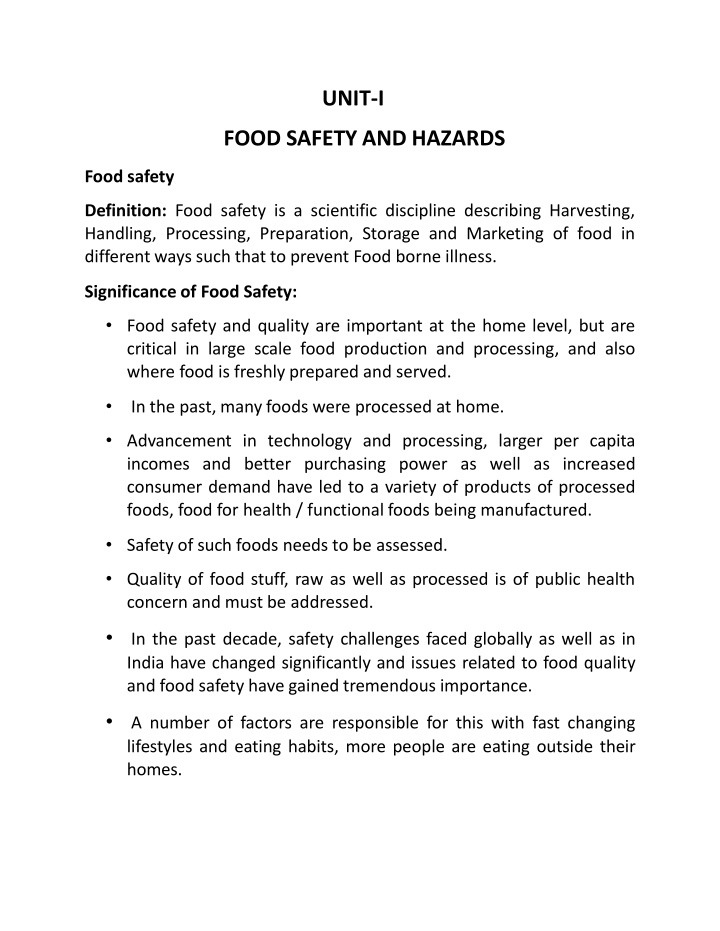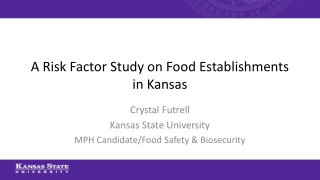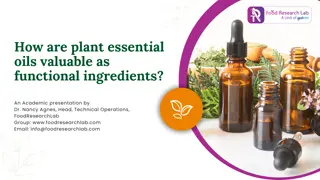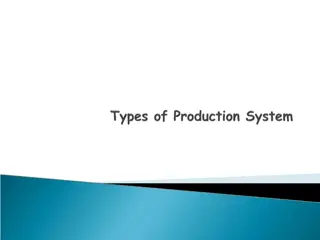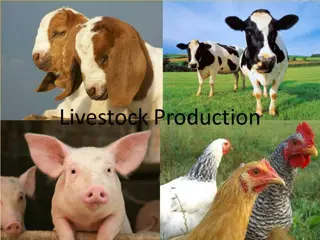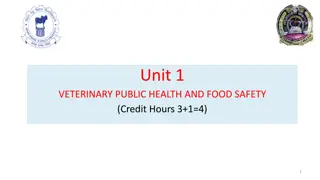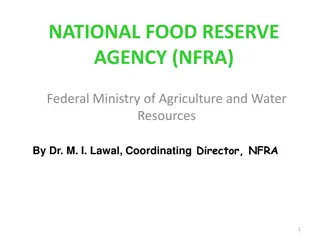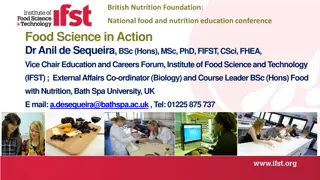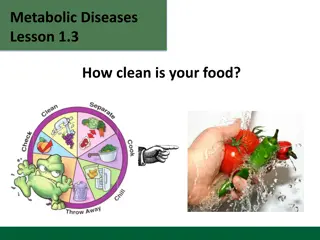Importance of Food Safety in Modern Food Production
Food safety is crucial in modern food production to prevent foodborne illnesses. With advancements in technology and increased demand for processed foods, the need to ensure the safety and quality of food has become paramount. Factors affecting food safety include poor hygiene practices, contaminated water, and inadequate storage. Addressing these factors through food hygiene, personal hygiene of food handlers, and kitchen sanitation is vital for safeguarding public health.
Download Presentation

Please find below an Image/Link to download the presentation.
The content on the website is provided AS IS for your information and personal use only. It may not be sold, licensed, or shared on other websites without obtaining consent from the author.If you encounter any issues during the download, it is possible that the publisher has removed the file from their server.
You are allowed to download the files provided on this website for personal or commercial use, subject to the condition that they are used lawfully. All files are the property of their respective owners.
The content on the website is provided AS IS for your information and personal use only. It may not be sold, licensed, or shared on other websites without obtaining consent from the author.
E N D
Presentation Transcript
UNIT-I FOOD SAFETY AND HAZARDS Food safety Definition: Food safety is a scientific discipline describing Harvesting, Handling, Processing, Preparation, Storage and Marketing of food in different ways such that to prevent Food borne illness. Significance of Food Safety: Food safety and quality are important at the home level, but are critical in large scale food production and processing, and also where food is freshly prepared and served. In the past, many foods were processed at home. Advancement in technology and processing, larger per capita incomes and better purchasing power as well as increased consumer demand have led to a variety of products of processed foods, food for health / functional foods being manufactured. Safety of such foods needs to be assessed. Quality of food stuff, raw as well as processed is of public health concern and must be addressed. In the past decade, safety challenges faced globally as well as in India have changed significantly and issues related to food quality and food safety have gainedtremendous importance. A number of factors are responsible for this with fast changing lifestyles and eating habits, more people are eating outside their homes.
In commercial settings, foods are prepared in bulk handled by many persons, thus there are more chances of food getting contaminated. Further, food items are prepared many hours in advance, and may spoil if not stored appropriately There are many processed and packaged foods. Safety of these foods is important. Spices and condiments, oilseeds were processed at home in former times and purity of these were not a concern. In today s world, pre packaged individual spices, condiments, spice powders and mixes are in demand, especially in cities and metros. Quality of even raw food stuff besides processed foods is of public healthconcern and must be addressed. Logistics governing transport of bulk food is complex and there is a long gap between processing and consumption. Thus risk assessment and safety management during mass production and mass distribution is critical. Microbial adaptations, antibiotic resistance, altered human susceptibility and international travelling have all contributed to increasing incidence of food-borne microbial diseases. Nearly half of all known food-borne pathogens have been discovered during the past 25-30 years. There are still many food borne illnesses of unknown etiology. This is an issue of global public health concern and there is a need to detect, identify and recognize emerging pathogens and
establish internationally. active surveillance networks, nationally and Factors effecting Food Safety: Generally foods are basic building blocks of living things. But sometimes they will become major factor for occurrence of some healthrelated harmful situations. The foods become harmful to human health when they are combined with micro organisms or with other toxic substances. In food the harmful nature will be developed due to several reasons such as: In appropriate agricultural practices. Poor hygienic conditions at any stage of food processing. Lack of preventive controls during processing and preparation of food. In correct use of chemicals. Use of Contaminated contaminated water during food preparation. In appropriate storage. All the above reasons are kept under 3 factors: a) Food Hygiene b) Personal Hygiene of food handlers. c) Kitchen Sanitation. d) Food Hygiene: Many factors are responsible for decreasing hygienic quality of food. Under poor hygienic conditions the food get contaminated at any stage i.e from harvesting to marketing leading to development of potentially harmful conditionsin the food. This conditionis called Food Poisoning. raw materials and
b) Personal Hygiene of Food Handlers: Personal Hygiene plays a very important role processing stage of food change. Food processing stage is completely dependent on food handlers. It was reported that food processing workers are capable of spreading nearly 10,000 to 1,00000 micro organisms every minute. So the food handlers should be disease free and should maintain personal hygiene during processing of food otherwise it can lead to cross contamination. The handlers/ workers should avoid certain behavior like smoking, coughing, sneezing, chewing and eating at the production site. Food Handlers also should avoid wearing gold ornaments, they should not grow nails. The food workers shouldwear gloves, aprons, and also should cover their hair. c) Kitchen Sanitation/ Kitchen Hygiene: Another important factor in the provision of food safety is kitchen sanitation. The planning and interior design of kitchen should be constructed in such a way as to provide proper hygienic practices. Kitchen surfaces should be designed in such a way that the dust accumulated. Proper ventilation eliminate smoke, odors, Soot and other dirt particlesfrom the kitchen. Drainages in the kitchen should be easy to clean and shouldbe feasible for preventing Pestslike Rodents form enteringinto kitchen. in food materials should not get system is necessary to
Equipment in the kitchen should be cleaned and disinfected regularly. FOOD HAZARDS Definition: Hazards refer to conditions or contaminants in foods that can cause illness or injury. There are 3types of Hazards: A) PhysicalHazards B) Chemical Hazards C) Biological Hazards D)Physical Hazards: A physical hazard is nothing but any potential harmful extraneous matter which is not normally found in food. These hazards cause personal injuries to the consumer which are actually not life threatening but can cause personal discomfort to the consumer. Examples of physical hazards: Metal Fragments. Glass Particles. Wood Splinters. Rock Fragments. Stones. Bone Fragments (Meat & Poultry). These hazards may enter the food by either equipment failure or breakage. Routine inspections and maintenance of equipments is good practice. The physical hazards present in food are detected by Control equipment such as Magnet-for detecting Ferrous metals. Metal detectors-for detecting Ferrous and Non-Ferrous metals.
X-ray equipments-for all types of physical hazards. Screens-for separating obstacles by size in liquid foods. Aspirators-used for segregating obstacles by weight in liquid foods. Riffle boards-removal of stones from beans. Bone separator- for mechanical separation of meat. Employees of food processing industries should be aware of company policies with regarding to hazard prevention. B) Chemical Hazards: There are different types of chemical hazards associated with food a) Naturally occurring chemicals b) Intentionally added chemicals(food additives) c) Unintentional or incidental chemical additives. a) Naturally occurring chemicals: Naturally occurring chemical hazards are present in many foods. for ex: toxins found in many varieties of mushrooms and some sea foods. So the consumer is aware about the foods which he was consumingmay containthese toxins. Some of the naturally occurring chemical hazards are: Scombrotoxin-found in Fishes. Saxitoxin-found in Shellfishes. Ciguatoxin-found in Finfish. Cyclopeptide toxin-found in Mushrooms. b) Intentionally added chemicals: These are 2types: Direct food additives: i)These are the compounds which are commonly called as Preservatives. Ex: Nitrites, Sodium Benzoates, Sulphates etc.
ii) Additives such as food colours and nutritional additives(Vitamins) are also considered as direct food additives. Indirect food additives: It includes components like: Adhesives,Polymers, Sanitizers etc. c) Unintentionally chemicals: There are a number of unintentionally added chemicals which are added to foods mainly by agricultural processes. They are pesticides, fungicides, herbicides, antibioticsetc. These type of chemicals are also added to foods from environmentalsources. They are: added chemicals/Environmentally added C) BiologicalHazards: Definition: Biological Hazards are the micro-organisms or chemicals produced by the micro organisms in the food that pose a threat to human healthwhen it is consumed.
The consequences caused due to Biological Hazards are outbreak of diseases called food borne diseases. The micro organisms acting as biological hazards are bacteria, fungi, algae, virus, protozoa and parasites. Types of Food Borne Diseases: There are 3 types of FBD. Food Intoxications Food Infections Food Borne Toxic Infections. Food Intoxications: It involves toxic substances produced in the food by micro organisms before it is consumed. The most important bacterial food borne intoxications are: Bacterial Intoxications: a) Staphylococcal Poisoning (Staphylococcosis): This disease is caused by the ingestion of entero toxin formed in food during the growth of certain strains of Staphylococcusaureus organisms. This entero toxins causes a condition called Gastro enteritis i.e, inflammation of lining of intestinal tract in human beings. Staphylococcus aureus is a small (0.5-1.0mm in diameter), gram-positive, non-motile, non-spore forming, cocci. It is aerobic and facultative anaerobic having growing temperature range of 70C to 480Celsius. Nature of Toxin: S aureus produces 5 types of entero toxins such as A, B, C1, C2,D and E. The commonly identified toxins involved in disease outbreaks are A & D.
The toxin is heat stable and can withstand pasteurization temperatures upto 30 minutes. But the organism is heat labile and can be destroyed easily by pasteurization process. Epidemiology: The incubation period is 1-6 hrs and in most cases it is between 2-4 hrs. Types of Foods: The common foods responsible for Staphyolococcal outbreaks are raw milk, raw meat, bakery foods, poultry, eggs etc. Control: Keep the handling of cooked foods to a minimum. The prepared foods should be held at a temperature above 560C. Cooling the cooked foods rapidly in a shallow containers at a temperature below 70C. Processing the foods with in a time span of 1-2 hrs in which Staphylococci will be in Lag phase. Minimizing cross contamination from raw food to cooked food. b) Bacillus cereus poisoning: B.cereus can cause 2 different forms of food poisoning, which differ both in their incubation time and the symptoms they elicit in the victim. It is a large (3-5micrometer long & 1-5 micrometer width), gram positive, motile and spore forming rod.
It is an aerobic organism but also have the capacity to grow under anaerobic conditions. The strains of B.cereus can grow at a temperature range of 40 C to 450C. Nature of Toxin: Different B.cereus strains produces 2 different types of toxins. i)Diarrhoeagenic toxin which causes Diarrhoea. It is a heat sensitive toxin and destroyed within 30 minutes at 560C and in 20 minutes at 600C temperatures respectively. ii)Emetic (Vomiting) toxin which causes Nausea and vomiting in the person, 2-5 hrs after food ingestion. It can resist high temperatures i.eupto 1260C for 90 minutes. It also causes acute abdominal pain,fever, chills, body aches. Epidemiology: The incubation period is between 8-16 hrs and lasts for less than 24hrs. Types of Foods: This organism majorly invades foods like cereal dishes, milk and dairy products, mashed potatoes, Sauces, chicken soups, Spices etc. Control: The rice cooked for preparation of fried rice should be boiled in small quantities whenever required, dependingon the customer inflow
which helps in reducing the holding period of cooked rice. If the rice has to be cooked in large portions should be kept at a temperature not less than 630C, if it is not possible it is divided into small portions and is cooled quickly at a temperature of less than 70C. c)Clostridium botulinum(BOTULISM): Botulism is an extremely serious Neurological illness caused by the ingestion of improperly preserved canned foods containing the toxin called botulin C.botulinum. C.botulinum is an mesophilic, motile, gram positive, rod shaped bacteria having 4-8 micrometers in length and 0.9-1.2 micrometers in width. C.botulinum is a psychrotrophic organism which grows at a temperature less than 3.30C. But its spores can withstandhigher temperatures. produced by the organism obligate, anaerobic, Nature of Toxin: There are 8 types of toxins produced by C.botulinum and are designated as A, B, C1, C2,D, E, F & G. All the strains of C.botulinum do not produce single toxin but some strains produces mixed toxins. These toxins are called neuro toxins as they act up on peripheral nerves of involuntary muscles of the body.
Epidemiology: The incubation period of the disease ranges from 2 hrs to 14 days after ingestion of contaminatedfood. The signs and symptoms of the disease totally depends on type of the toxin ingested. The general symptoms are Nausea, Vomiting but occasionally Diarrhoea, Head ache, Dizzy ness, Constipation & Blurred vision. Type of food: It is mostly present in fish and its products, marine animals, meat, fruits and vegetables including mushrooms. The insufficiently heated canned and bottled foods are at high risk as they provide anaerobic conditions for the organism to grow. Control: The botulism can be prevented by killing C.botulinum spores in foods through the following steps: Processing Eliminating processed foods. Destroying the toxins by proper heating of processed foods before serving. Proper storage. Discarding the food that has developed the signs of spoilage. the recontamination of
Avoiding tasting of suspected food unless it is heated to 1000C. A heat process called botulinum cook is commonly recommended for low acid canned products. Fungal Intoxications(myco intoxications): The toxins produced by fungi are called Mycotoxins. a) Afla toxins: These are potent toxins produced by Aspergillus spp. Ex: A.flavus, A.oryzae, A.ochraceus etc This toxin is highly carcinogenic in nature which causes liver cancer in humans. It is also produced by Penicillium spp. Ex: Penicillium citrinum. Afla toxin mainly present in improperly stored staple foods such as cassava, chilli, peppers, cotton seeds, rice, peanuts,sweet corn etc, b) Ochratoxins: It is first isolated from filtrates of Aspergillus Ochraceus But recently it was discovered that, it is also produced by remaining Aspergillus spp and Penicillium spp Ochratoxin has different subtypes of this ochratoxin A (OTA) is highly potent. It causes nephrotoxicity and carcinogenicity. Ex: remal cancer It is related to a derivative of isocaumarin (phytochemical) but is linked with the L-Phenyl alcohol. It occurs in foods like coffee beans, peanuts, etc, contaminated with the above fungus.
c) Trichothecenes: It is produced by species of fusarium, cephalosporium, gyrothecium,Trichoderma,stachybotry s. There are nearly 30 different types of trichothecenes toxin out of which deoxynivalemolare common occurrence in foods. This is also known to cause hyperstrogenic syndrome. It is found to occur in foods like corn, wheat, barley, rice, veg s etc. T-2 toxin, nivalemol and d)Zearalenone: This toxinis produced by Fusarium spp. Ex: Fusariumgraminearum moniliforme It occurs mainly in maize. It has effects similar to trichothecenes. d)Patulin: It is produced by fungal strains like penicillium, Aspergillusetc. Ex: penicillium patulinum Penicillium expansumetc. It majorly occurs in apples(brown rot) & apple products, grapes, peaches, olives, apricots etc. It causes Neural syndromes, brain hemorrhage, lung & skin cancer etc, when we take contaminated food containingthis toxin. d)Amatoxins and Phallotoxins: These produced by poisonous mushrooms called Amanita Phalloides which is also calleddeath cap. two mycotoxins are considered to be
These two toxins are chemicallycyclopeptides. These are highly potent toxins and Amatoxin is highly potential toxin than phallotoxin Amatoxin is of 2 types Alpha-amatoxin Beta-amatoxin Phallodin is the most potent phallotoxin. The symptoms of these toxins include Hypoglycemia Liver dystrophy Kidney failure These toxins are mostly make the person to become fatal. g)Coprine: It is a toxon present in an edible mushroom called coprinus atramentanius. It results in gastrointestinal discomforts in body. This toxin is pathogenic to humans when these particular mushrooms are taken along with alcohol. upsets and other h)Gyromitrin: It is a deadly poisonous mycotoxin reported to be present in fruiting bodies of basidiomycota genus of Helvellaspp & Gyramitra spp. This toxin will get diluted and disappeared when these mushrooms are parboiled two or three times and the liquid discarded & mushroom becomes safer to eat.
Food Borne Infections: These are caused by the ingestion of pathogenic microorganisms that penetrate the intestinal mucosal membrane and migrates to other tissuesfor multiplication. BacterialInfections: a) Salmonellosis: It is a common food borne infection caused by 1600 different strains of salmonella spp. The most important strain is Salmonella typhi which causes typhoid. These are short(1-2 u meters),motile, gram-negative, non sporing rods, aerobic and facultatively anaerobic organisms. They grow at temperature of 80C-450C. Salmonellosis occurs by the ingestion of viable cells of organisms The occurrence of the disease is completely depend on resistance of the individual, type of strain involved and number of bacteriaingested. Epidemiology: The incubation period varies forms 6hours to 3days. The symptoms are nausea, diarrhoea, abdominal pain, vomiting and fever and in some cases chill and head ache. Types of Food: The food like contaminated meat and its products, egg and its products , dessicatedcoconut ,ice creams etc are responsible for spread of disease. Control: Regular checking of animal whether it is contamination. Avoiding cross-contamination. Proper cooking of food. free from
Cooling the prepared foods rapidly below 70C(or)held at a temp . above 600C. b) Shigellosis: Shigellosis is caused by the organisms shigella. Shigella genus has 4 groups i) shigellasonnie ii) shigellaflexneri iii) shigellaboydii iv) shigelladysenteriae These are non-motile, non-sporulating ,aerobic and facultatively anaerobic ,gram-negative rods. They grow at a temperature range 100C-400C. mode of transmission: Mode of transmission is from human to human. Epidemiology: The incubation period is from 1-7 days. The symptoms are diarrhoea with blood , mucos and pus in faecus , fever , nausea sometimes vomiting and abdominal cramps Types of Food: Major out break is due to contaminated water. Milk , Shelfish, Row vegetables, salads etc . will acts as vehicles of infection . Control: The food material which is the primary carrier, was to be made to follow strict personal hygiene. The left over food should be chilled rapidly(OR) should be held at a temperature of >400C.
Cooking(or)reheating of food to safer temperature is also very essential. c) Vibrio para haemolyticus: Vibrio para haemolyticus associated gastroenteritis is the name of infection caused by the organism. The organism facultatively anaerobic , slightly curved ,motile , gram-negativerod. It grows at a temperature range 0f 80C-440C. Mode of transmission: Mode of transmission is from contaminated food to humans. Epidemiology: Incubation period is from 12-24hrs Symptoms are severe abdominal pain vomiting and diarrhoea, leading to dehydration and fever. Types of Food: Crabs, shrimps and certain fresh water fishes . Control: Though cooking of sea foods. Avoiding cross-contamination of raw food. Proper refrigeration of raw sea foods d) Enteropathogenic E.Coli( EPEC): Enteropathogenic organism, its presence in food has been as an indicator for faecal contamination in water. E.Coli are short ,gram-negative, non spore forming, motile, facultative anaerobic organisms. They grow at temperature range of 70C-430C. cooked food from coil (E.coli) is an important
Mode of transmission: Mode of transmission is from contaminated food to humans , infected person to healthy persons. Epidemiology: The incubation period is between 12-72 hours The symptoms include diarrhea, vomiting, abdominal fever . Types of food acting as reservoirs: Poultry, beef products , pork, lamb, dairy products etc Control: It is control by adopting strict personal hygiene and good sanitary practices. abdominal pain, bloody Viral Infections: a) Hepatitis Virus (Hepatitis): This virus cause infection hepatitis. This virus is presumed to replicate initially in the gastro intestinal tract and then it spreads primarily to liver cells (hepaticcells). Mode of transmission: The disease is transmitted through faeco-oral route. Epidemiology: Incubationperiod is between 15-50 days Symptoms are jaundice yellowish-green white of eyes, skin and mucus membrane caused by deposition of bile sacks. Types of food acting asreservoirs: Shellfish from polluted water, fruits vegetables , salads etc and
Control: Following proper personal hygiene practice. b) Noro Virus(Norwalk virus) & Rota virus: Noro virus is also called as winter vomiting bug. These are non enveloped viruses causing gastero enteritis or stomachflu. Mode of transmission: The virus transmitted from humans to humans. Epidemiology: Incubationperiod is between 12-48 hours. Symptoms are vomiting , diarrhoea ,abdominal pain, head ache, nausea & occasionally low grade fever Types of Food acting as reservoirs: Raw (OR) under cooked oysters & row fruits & vegetables , contaminatedwater & beverages etc. Control: Following good hygienic practice for food preparations. Maintaining good standard of infection control is hospitals and nursing homes. c) Polio Virus(Poliomyelitis): It is an enteric virus. This virus infects a person spinal cord, causing paralysis. Mode of transmission: This virus transmitted by faeco-oral route. Epidemiology: Incubation period is 7-21 days. Symptoms are fever , head ache , nausea , fatigue sore throat,pain in arms and legs, neck stiffness.
Types of food: Contaminated water & dairy products, rawfood materialsetc . Control: Maintaining personal hygiene Giving polio vaccine etc . Protozoan Infections: Entamoeba Hystolitica: It causes disease called Amoebiasis. It is a protozoan organism. Mode of Transmission: Transmission is by faceo-oral route. Types of Food: Contaminated food & water etc. Epidemiology: Incubation period is from weeks to untreated. Symptoms are loose stools, mild abdominal pain, fatigue, loss of appetite. years when Control: By maintaining good hygiene and proper sanitory conditions the disease is prevented.
Food Borne Toxic Infections: These are caused by the injection of a large number of entero toxigenic strains of microorganism which multiple in the intestine producingentero toxins in the intestine. a)Clostridium perfringens: It is a large , non-motile,gram-positive ,obligate anaerobic , spore forming rod . It will grow at a at a temperature range of 150C-550C. Nature of Toxin: The strains of C.perfringens are classified into five depending on the type of toxin types(A to E), produced. Epidemiology: The incubation period is between 8 to 22 hours Symptoms are severe diaarhoea , vomiting. abdominal cramps, water Types of Food: Food such as raw meat &poultry, ready to eat food etc. Control: The cooled food should be held be consumed as early as possible. The food should be held at temperature above 560C or higher,if there if there is a delay in consuming. The food should be cooled rapidly and held below 70C. b)Entero Toxigenic Escherichia Coli(E.T.E.C): This bacterium normally use in the lives in the intestine of humans. Some of E.Coli produces special living of human fluid secretion thus producingdiarrhoea. strains are toxigenic that toxic which stimulation the intestines causing excessive
Nature of Toxin: It is also called as travelers diarrhoea. ETEC produces two type of toxin Heat stable toxin(S T) Heat labile toxin(LT) Epidemiology: The incubation period is between 8-44 hrs. The symptoms are fever, nausea, chills, loss of appetite, head ache, muscle ache and sometimes chius headache. Types of Food: Water, drinks, raw veggies. Control: Washing hands frequently. Food should be properly cooked. c)Cholera: Caused by the organism Vibrio cholera. It is aerobic , facultatively anaerobic, straight or slightly curved, short, gram negativerods. Nature of Toxin: V. cholera produces heat sensitive entero toxin cohile growing in human intestine. Epidemiology: Incubation period of cholera range from fewhours to 5 days. The symptoms include abrupt onset of vomiting & waterly diarrhoea usually called rice waterly stools . Types of Food: Contaminated water and contaminated food. Control:
Cholera is controlled by safe disposal of sewage and also through supply of protected water. d)Listeriosis: Lesteriosis is caused by pathogenic bacterium Listeria mono cytogenes. It is a gram positive, motile, non-sporing, rod shaped, aerobic and facultatively anaerobicrods. Nature of Toxin: The toxin produced is Listeriolysin O(LLO) which is a core forming toxin. Epidemiology: Incubation period is between one to several weeks. The symptoms are meningitis or septicemia in pregnant women. Chills, body pains, vomiting, diarrhoea. Types of Food: Milk and dairy products, meat & meat products, raw veg s, saladsetc. e)Yersinea Enterocoritica(Gastro enteritis): Yersiniosis bacteriumYersinia. It is gram negative, rod shaped bacteria. Nature of Toxin: It produces enterotoxin which can resist the temp of 100 degree celcius for 20 min. Epidemiology: Incubation period is nearly 24 hrs. Symptoms are abdominal pain, fever, and diarrhoea. is an infectious disease caused by
The Appendicites . Types of Food: Dairy products, egg products, raw meat, poultry vegetables. Control: Proper cooking of food. Following proper hygienic conditions. f)Campylobacter jejuni: It is small, spiral, motile, gram negative, rod shaped bacteria. Nature of Toxin: Distending cytoletinal toin(CDT) is produced. abdominal pain in this case resembles Epidemiology: Incubation period ranges from 1-10 days. The symptoms are abdominal cramps, diarrhoea, fever. Types of food: Dressed chicken, raw milk, raw sea food. Control: Prevented by proper cooking and pasteurization of milk. Temperature Control on Food Processing: Definition: Temperature control is a set of procedures, strategies, measurements, and conditions established to meet and maintain the standards and specifications of the given product with regarding temperature. to Temperature control in food is assessed by extent of bacterial growth. Generally bacterial growth in food effected by 6 important factors:
i) ii) iii) iv) v) vi) Food Acidity Time Temp Oxygen Moisture F A T T O M Off all these 6 factors, time and temperature play a vital role in bacterial growth. At the extreme higher temperature and at extreme low temperature the bacterial growth rate will get rapidly shows down or gets stopped. So time required for spoiling food becomes more and hence shelf life of food increases. The food which is subjected to temperature control is called TLS food. Temp is vital for food safety assurance and is used a) To process food products. b) To give desired sensory characteristics of food. c) To control microbial growth. Many food safety management systems will design different prerequisite programs for implementing food safety. Eg: HACCP, ISO etc. One of the important prerequisite programme is Temperature Control Programme (TCP).
Temperature range of different foods: Danger zone: It is a temperature range b/w 5 degree to 6 degree Celcius in which foods get easily spoiled because it is favourable for growth of different microorganisms. Application of temperature control: Temperature helps to ensure the safety of food products throughout all stages of food supply chain.
It is a dominant food safety and quality control parameter across supply chain. Types of micro organsisms invaiding food with regarding to temperature: Destroying the spoilage causing microorganisms in the major target for temperature control. Based on this microorganisms are Hyperthermophile (60 degrees C and upwards) Thermophile (optimal growth between 45 and 122 degrees) Mesophile (20 and 45 degrees C) Psychrotrophs (will survive at 0 degrees C, but prefer mesophilic temperature Psychrophiles (-15 and 10 degrees C or lower) Addition of Heat: Use of temperature b/w 90 degree-120 degree may act as a kill factor against MO s TEMPERATURE PROCESSES TO AVOID MICRO ORGANISMS Removal of Heat: Use of freezing and refrigiration temperatures (-20degree to -40degree) may inhibits all chemical and biological reactions. Components programme: and Equipments of temperature control A facility should be established in temperature control mechanisms to significantly minimize or prevent the growth of spoilage and pathogenicmicro organisms.
That facility must conduct the following activities as appropriate to ensure the effectiveness of temperature control. Identifying the target products, Ingredients, additives and raw materials for temp control. Definingoptimaltemperature conditionsfor such foods This temperature conditions should not decrease the nutritive value of foods. Eg: Baking, Pasteurization, cold storage. Establishing appropriate temperature measurement and monitoring devices (Eg: thermometer), recording devices (Eg: data loggers). Such systems are placed at various critical stages of food supply chain where temperatures is necessary. Taking corrective actions outsides the reasonable control limits that may impact food safety. Reviewing records of corrective actions taken to correct a problem with a certain period of time.
